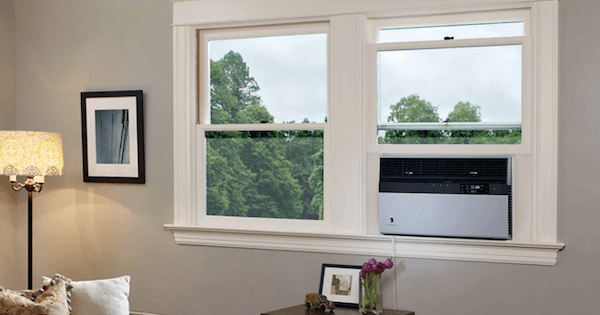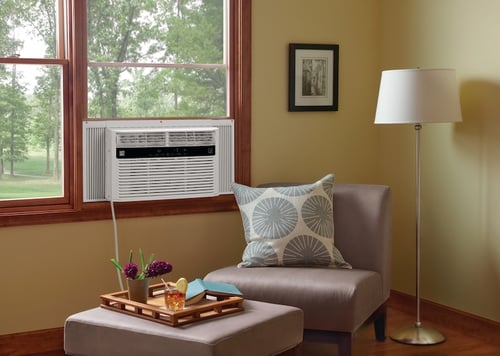
There are a lot of things we look forward to in the summer, like the sun setting at 8PM instead of 5PM, but on hot, muggy days you might catch yourself wishing for November! Keeping comfortable with an air conditioner helps us appreciate summer with a little less sweat. Although it can be tempting to grab the closest (and cheapest) air conditioner you can find, figuring out what size air conditioner you need can help you spend your money wisely and get great results.
Table of Contents
- Why Size Matters
- How Air Conditioner Sizes are Measured
- Step 1: Determine Square Footage
- Step 2: Make Additional Adjustments
- Step 3: Do You Need Multiple Air Conditioners?
- What About Dimensions?
Why Air Conditioner Size Matters
Air conditioners cool down your space, but they also dehumidify it to make you feel even cooler. An air conditioner that's too big and powerful for the space will cool it quickly without dehumidifying it, so the space will feel damp and clammy - not fun! Plus, since most window air conditioner compressors are pretty simple and only run at one speed (so they're either on or off, with no slower speeds to suit smaller spaces), it typically wastes energy, too.
An air conditioner that's too small, of course, will have to work really hard constantly to try to cool the space, and if it's particularly undersized than it may never really succeed at its job! This is obviously frustrating for you, and, again, it wastes energy.
Wasting energy means more dollars out of your pocket being spent on electricity. So you're in the right place - Let's find the perfect size of air conditioner for you!
How Air Conditioner Sizes are Measured
Air conditioner size is listed as a BTU rating, which is actually "BTUs/hour." BTU stands for British Thermal Units, and BTU/hour measures the rate that the air conditioner can remove heat. A larger BTU rating means a more powerful air conditioner. The smallest air conditioners are around 5-6,000 BTUs, while 12,000 BTUs and up can be used to cool very large spaces.
Most people are looking for an air conditioner to cool a room or perhaps an apartment or part of an open floor plan. We'll help you figure out what size of air conditioner you need for any space.

Step 1: Determine the Room's Square Footage
Calculating the square footage is the first step to sizing an air conditioner. Take the length and width of the room in feet and multiply them to get the square footage. For triangular rooms, multiply the length of the room by the width and divide by two. For complex room shapes, cut it up into rectangles, squares, and triangles and use these formulas to find the square footage of each portion, then add it up.
Here is a basic table of square footage to capacity needed (in BTUs/hour):
| Square Footage of Area | BTU Capacity Needed |
| 100-150 | 5,000 |
| 150-250 | 6,000 |
| 250-300 |
7,000 |
| 300-350 | 8,000 |
| 400-450 | 10,000 |
| 450-550 | 12,000 |
| 550-700 | 14,000 |
| 700-1,000 | 18,000 |
Different resources may list slight variations on these numbers, but it generally boils down to 20 BTU per square foot. We drew our reference from the Energy Star website. So for a bedroom or home office you may need 8,000 BTUs at most. For a master bedroom or large den area, you could be looking at 10,000 BTUs. Open floor plans may require 12,000+ BTU air conditioners. These more powerful units may require a 210/220 volt outlet so keep that in mind when you're shopping.
When it comes to portable air conditioners, you'll want to get a more powerful unit than you think you need, especially if you are on the "cusp" of needing a higher BTU air conditioner (e.g. for a room that's 250 square feet, you could get a 6,000 or 7,000 BTU model). Portable models generate waste heat that offsets their cooling ability, reducing their overall efficiency. You should pay attention to the DOE BTU rating, which often isn't listed as prominently as the plain BTU rating. The DOE rating is often close to half of the "plain" BTU rating because it accounts for the efficiency issues of portable models. Compare portable vs window ACs here.
If you are looking into a central air conditioning system for your whole house, you can get a ballpark estimate yourself but ideally you should be working with an HVAC vendor to figure out the ideal size. With central air, the rating typically used is called a "ton" instead of in BTUs. One "ton" of air conditioning = 12,000 BTUs. You can cool about 400-600 square feet per ton of capacity (this varies depending on climate). So for a 1,600 square foot home, you'll likely want a 4.0 ton central air conditioner. For 2,000 square feet, you'll want around 5.0 tons.
But that's not the only factor in which air conditioner size you need...
Step 2: Make Additional Capacity Adjustments
Energy Star offers some additional guidelines:
-
Is the room heavily shaded? -> Reduce capacity by 10%.
-
Is the room very sunny? -> Increase capacity by 10%.
-
Do more than 2 people regularly occupy the room? -> Add 600 BTUs for each additional person. Humans put out a lot of heat!
-
Is the unit going to be installed in a kitchen? -> Increase capacity by 4,000 BTUs. (This compensates for the heat from your refrigerator as well as your stove and oven.)
You may also want to look for a slightly higher BTU output if you have high ceilings.
Step 3: Do You Need Multiple Air Conditioners?
Air conditioners typically aren't very good at pushing cool air around corners. For open floor plans where airflow isn't restricted, a single large air conditioner could do the trick as long as it has enough fan power. For closed floor plans with more individual rooms, you would likely benefit from multiple small window units. You could set up fans to help push air throughout a space, but too many of these can get in the way and the wires can even present a trip hazard.
Window units are relatively inexpensive, so you're probably better off buying multiple window units if the space calls for it and if your budget allows for it.

What About Air Conditioner Dimensions?
If you're here to learn about typical window air conditioner dimensions, we've got you covered! Window air conditioners typically get wider and deeper the higher their BTU capacity rating. Most models come with adjustable side panels that collapse to a minimum width - in some cases you may be able to remove these side panels entirely if needed for a particularly narrow window.
Typically the smallest and narrowest window width is 22-23 inches (with a max of 36 inches wide) and the height typically needs to be at least 15-16 inches. Keep in mind that the required window dimensions are for the inside width and height since the unit will sit inside of the window frame.
If you have a crank-out or casement window, you'll want a casement air conditioner designed for vertical openings. These air conditioners are narrower to fit this type of window. However, there aren't a lot of options on the market today - in which case, a portable air conditioner may be a better choice. Portable air conditioners are noisy and they aren't as efficient as a window air conditioner, but they can be an economical choice with tough setups like this.
When it comes to through the wall air conditioners, if there is a preexisting sleeve, this will determine the dimensions of the replacement air conditioner. Different brands have different standard sleeve sizes, but most sleeves are 24.5, 26, or 27 inches wide. Friedrich offers Uni-Fit models that fit existing sleeves from 24.5-27 inches.
We hope this article helped you figure out what size of air conditioner you need! If you have any other questions related to air conditioner size, leave us a comment below. We'd love to hear from you!





